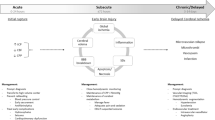Summary
During the period between 1978 and 1980, 43 patients with cerebral aneurysms were operated on within 48 hours of their last subarachnoid haemorrhage. The operative mortality rate of these cases was 2.3%. Based on our own success and failure in direct operation on ruptured cerebral aneurysms, we discuss our surgical methods and conceptions concerning surgery on ruptured aneurysms in the peracute stage.
Similar content being viewed by others
References
Drake, C. G., Ruptured intracranial aneurysms. Proc. R. Soc. Med.64 (1971), 477–481.
Hunt, W. E., Hess, R. M., Surgical risk as related to time of intervention in the repair of intracranial aneurysms. J. Neurosurg.28 (1968), 14–19.
Krayenbühl, H. A., Yaşargil, M. G., Flamm, E. S., Tew, J. M., Microsurgical treatment of intracranial saccular aneurysms. J. Neurosurg.37 (1972), 678–686.
Kamiyama, K., Okada, H., Sonobe, M., Endo, S., Hori, S., Suzuki, J., The mechanism of cerebral vasospasm induced by oxyhemoglobin. Neurol. Med. Chir., Program of the Japan Neurological Society, Tokyo, 1979.
Locksley, H. B., Report on the cooperative study of intracranial aneurysms and subarachnoid haemorrhage. Section V, Part II: Natural history of subarachnoid haemorrhage, intracranial aneurysms and arteriovenous malformation: Based on 6368 cases in the cooperative study. J. Neurosurg.25 (1966), 321–368.
Pool, J. L., Bifrontal craniotomy for anterior communicating artery aneurysm. J. Neurosurg.36 (1972), 212–220.
Sonobe, M., Suzuki, J., Vasospasmogenic substance produced following subarachnoid haemorrhage and its fate. Acta neurochir. (Wien),44 (1978), 97–106.
Suzuki, J., A method of prolongation of temporary stopping of the cerebral blood flow (Presidential Address). XXXIII Annual Meeting of the Japan Neurosurgical Society, Sendai, Oct. 22, 1974.
Suzuki, J., Yoshimoto, T., Hori, S., Continuous ventricular drainage to lessen surgical risk in ruptured intracranial aneurysms. Surg. Neurol.2 (1974), 87–90.
Suzuki, J., Prognosis of 1000 pure saccular aneurysms operated upon. In: Cerebral Aneurysms (Pia, H. W., ed.), pp. 28–41. Berlin-Heidelberg-New York: Springer. 1979.
Suzuki, J., Onuma, T., Yoshimoto, T., Results of early operations on cerebral aneurysms. Surg. Neurol.11 (1979), 407–412.
Suzuki, J., Yoshimoto, T., The effect of mannitol in prolongation of permissible occlusion time of cerebral artery—clinical data of aneurysm surgery. Neurosurg. Rev.1 (1979), 13–19.
Suzuki, J., Komatsu, S., Sato, T., Sakurai, Y., Correlation between CT findings and subsequent development of cerebral infarction due to vasospasm in subarachnoid hemorrhage. Acta neurochir. (Wien)55 (1980), 63–70.
Yoshimoto, T., Uchida, K., Kaneko, U., Kayama, T., Suzuki, J., An analysis of follow-up results of 1000 intracranial saccular aneurysms with definitive surgical treatment. J. Neurosurg.50 (1979), 152–157.
Author information
Authors and Affiliations
Rights and permissions
About this article
Cite this article
Suzuki, J., Kodama, N., Yoshimoto, T. et al. Ultraearly surgery of intracranial aneurysms. Acta neurochir 63, 185–191 (1982). https://doi.org/10.1007/BF01728871
Issue Date:
DOI: https://doi.org/10.1007/BF01728871




